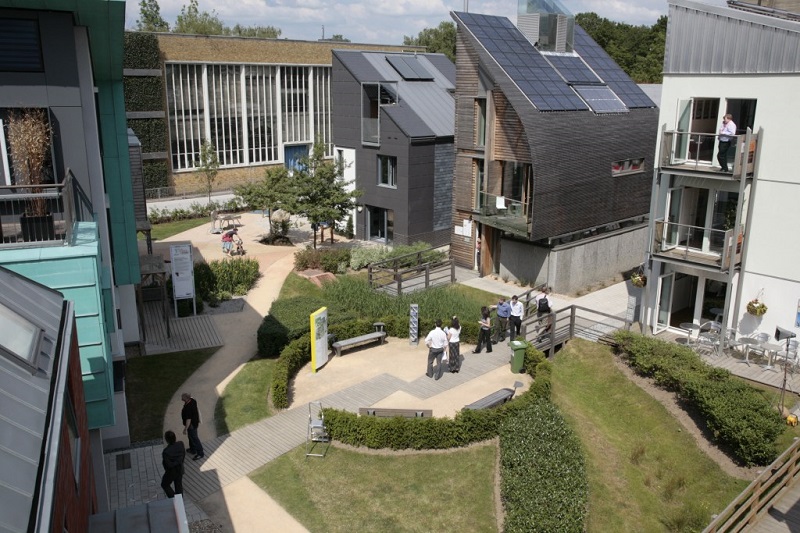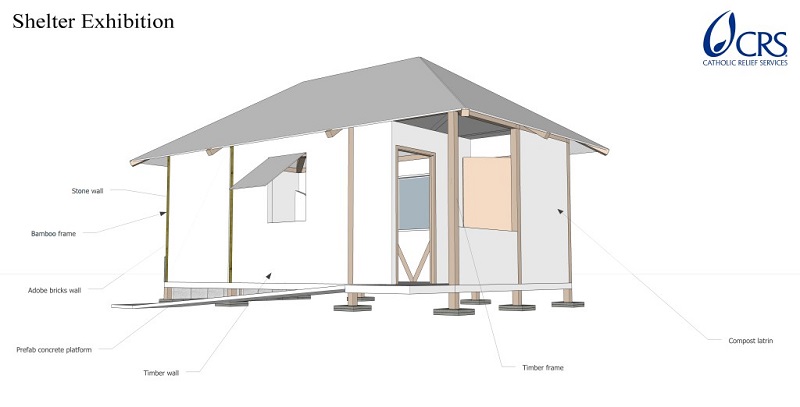Buildings that help rebuild lives and communities
With the increasing impact of climate change the number of natural disasters is growing rapidly. How do we ensure that affected communities can quickly and sustainably recover and rebuild their lives and communities?
Providing shelter for displaced people and families is one of the first critical components of disaster relief. Shelters need to be designed for resilience, rapid construction and deployment, but also crucially able to make use of local skills, labour and materials.
It is with this in mind that CRS (Catholic Relief Services) and BRE (Building Research Establishment) have been collaborating to create a demonstration of the techniques and materials that can be used to create an effective humanitarian shelter. How a shelter contributes to the wider humanitarian effort and rebuilding process will also be considered.
CRS has long experience as agency that alleviates suffering and provides assistance to people in need in more than 100 countries. CRS’ relief and development work is accomplished through programmes of emergency response, HIV, health, agriculture, education, microfinance and peacebuilding.
Working with the IFRC, BRE has pioneered the development of QSAND, the self-assessment sustainability tool focused on shelter and settlement reconstruction in the aftermath of natural disasters.
“Our collaboration with BRE is designed to create a focal point for demonstration and research in the provision of humanitarian shelters”, says Jamie Richardson, Shelter and Settlements Technical Advisor for CRS.
“The exhibition unit we are creating for the BRE Innovation Park in Watford [see top image] is a based on the Sphere Standards for shelter building. Sphere is a voluntary initiative from wide range of humanitarian agencies to improve the quality of humanitarian assistance. The unit will, in fact, be an amalgam of various techniques and materials, showing how various vernacular materials such as bamboo, adobe bricks and mud construction can be used in different parts of the world.”
The shelter will cover an area of 17.5 sq. m and be designed to be occupied by a family of five. This size unit is typical of the usual minimum space allocation of shelters around the world. It will aim to demonstrate materials and construction techniques, and also be the focal point for a research and demonstration programme on process and non-technical issues.
For example, a composting toilet is to be integrated into the shelter structure, to show the linkage with health and sanitation programmes. It will also incorporate features such as the inclusion of inner partitions for privacy and to address the needs of women and children.
“Our aims are to share information with stakeholders and the wider public and media on these issues” says Richardson. “It will be part of our outreach to building professionals and materials experts, and act as a stimulus for wider research and understanding on issues such as climate change resilience and sustainability”.
The home of the demonstration unit is the BRE Innovation Park at Watford, which features full-scale demonstration buildings that have been developed by industry partners across the built environment. These buildings display innovative design, materials and technologies which combine to address the development challenges facing regions across the world.
This article was originally published here by BRE Buzz on 29 June 2017. It was written by Simon Guy.
--BRE Buzz
[edit] Related articles on Designing Buildings Wiki
- BRE Buzz articles on Designing Buildings Wiki.
- Designing resilient cities: a guide to good practice (EP 103).
- Engineering resilience to human threats.
- Future proofing construction.
- Helping communities recover from disasters and protecting them before they occur.
- Humanitarian shelter exhibition.
- KODA house.
- Managing and responding to disaster.
- QSAND application in Nepal.
- QSAND and the Sustainable Development Goals.
- Resilience.
- Social and sustainable communities.
- Two steps towards a more resilient world.
Featured articles and news
Ebenezer Howard: inventor of the garden city. Book review.
The Grenfell Tower fire, eight years on
A time to pause and reflect as Dubai tower block fire reported just before anniversary.
Airtightness Topic Guide BSRIA TG 27/2025
Explaining the basics of airtightness, what it is, why it's important, when it's required and how it's carried out.
Construction contract awards hit lowest point of 2025
Plummeting for second consecutive month, intensifying concerns for housing and infrastructure goals.
Understanding Mental Health in the Built Environment 2025
Examining the state of mental health in construction, shedding light on levels of stress, anxiety and depression.
The benefits of engaging with insulation manufacturers
When considering ground floor constructions.
Lighting Industry endorses Blueprint for Electrification
The Lighting Industry Association fully supports the ECA Blueprint as a timely, urgent call to action.
BSRIA Sentinel Clerk of Works Training Case Study
Strengthening expertise to enhance service delivery with integrated cutting-edge industry knowledge.
Impact report from the Supply Chain Sustainability School
Free sustainability skills, training and support delivered to thousands of UK companies to help cut carbon.
The Building Safety Forum at the Installershow 2025
With speakers confirmed for 24 June as part of Building Safety Week.
The UK’s largest air pollution campaign.
Future Homes Standard, now includes solar, but what else?
Will the new standard, due to in the Autumn, go far enough in terms of performance ?
BSRIA Briefing: Cleaner Air, Better tomorrow
A look back at issues relating to inside and outside air quality, discussed during the BSRIA briefing in 2023.
Restoring Abbotsford's hothouse
Bringing the writer Walter Scott's garden to life.
Reflections on the spending review with CIAT.
Retired firefighter cycles world to raise Grenfell funds
Leaving on 14 June 2025 Stephen will raise money for youth and schools through the Grenfell Foundation.
Key points for construction at a glance with industry reactions.

























